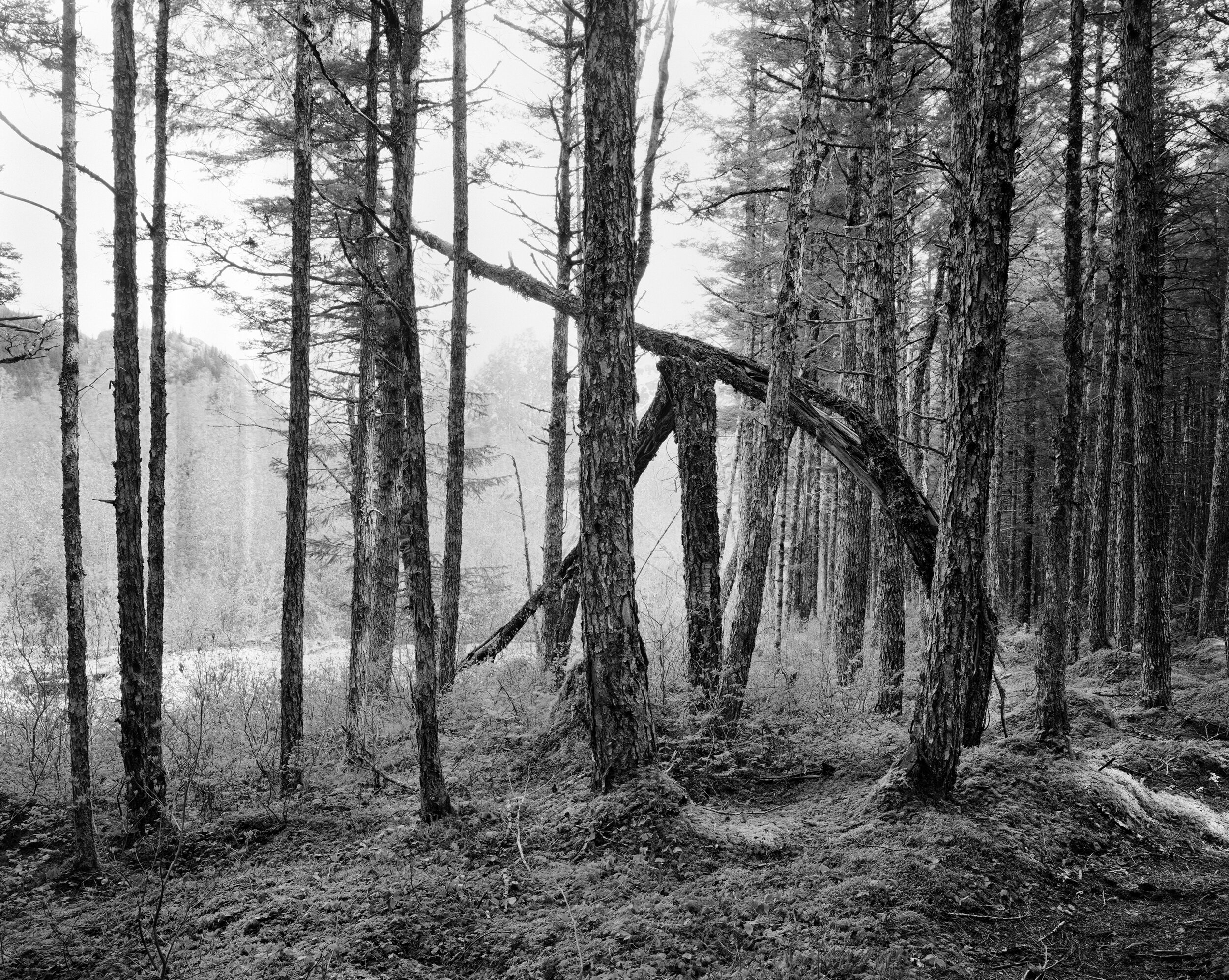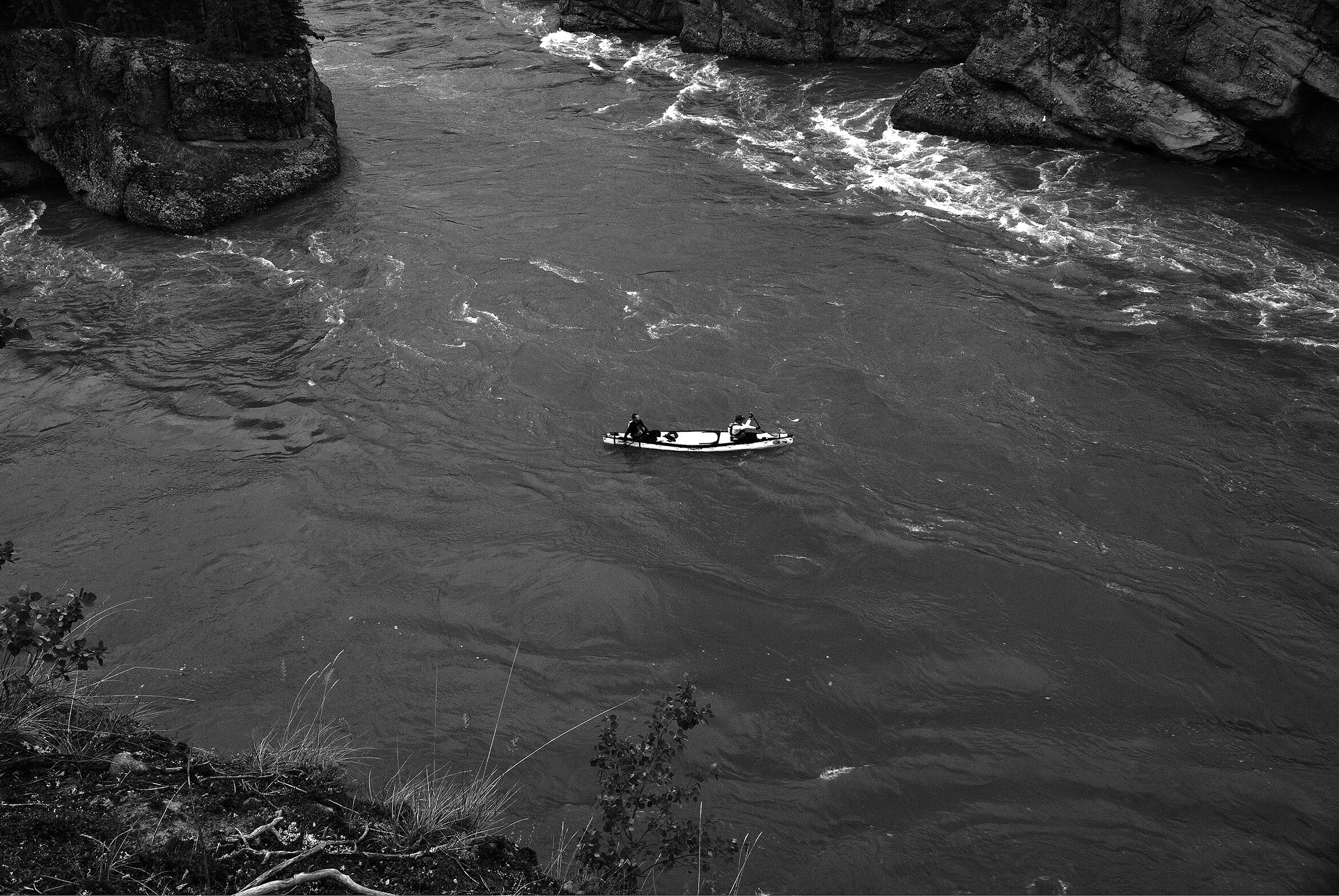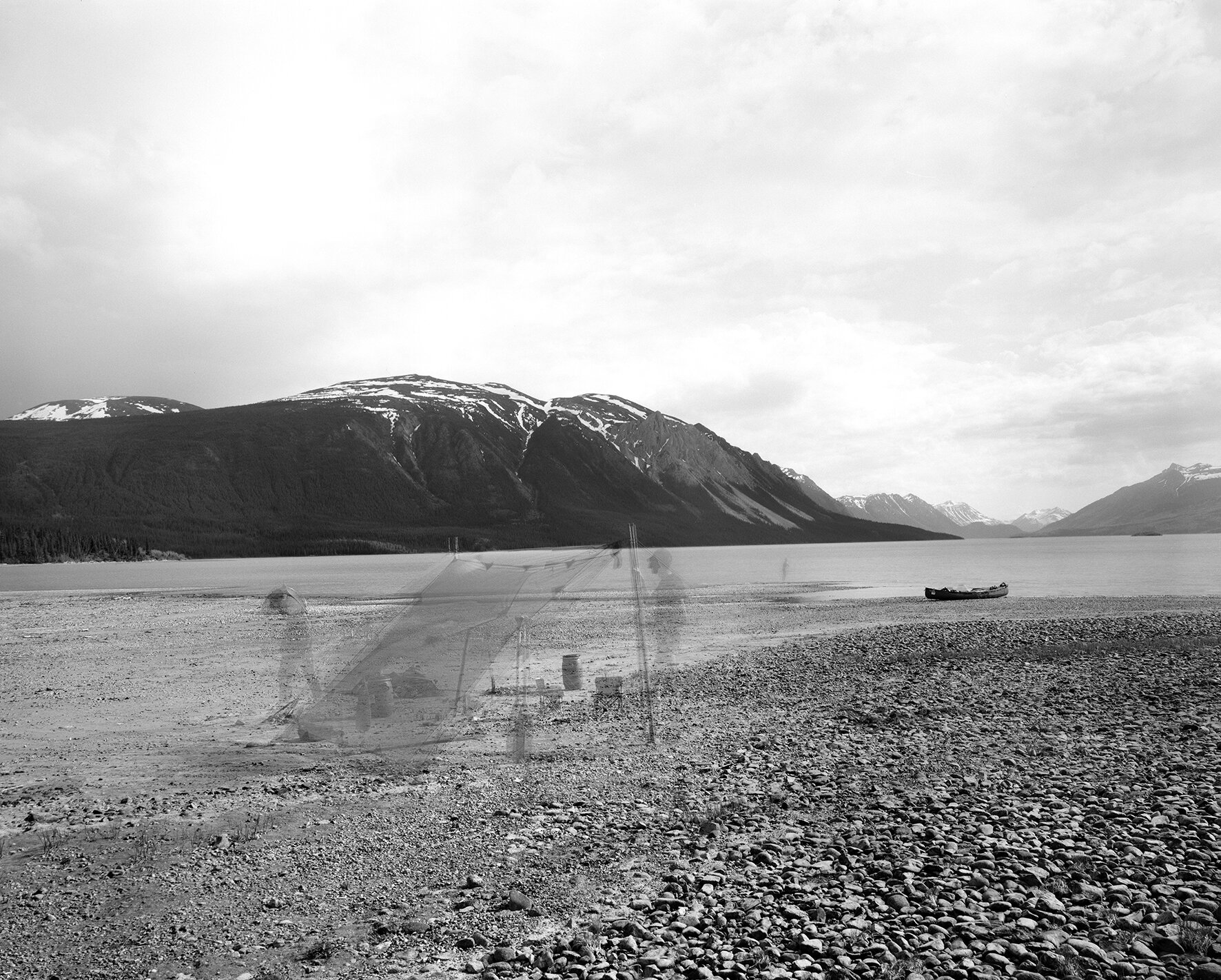
A cache in the woods, bear-proof building used to store food.

This is The Law of the Yukon, that only the Strong shall thrive; That surely theWeak shall perish, and only the Fit survive.
Robert Service


Living conditions were miserable in the miners cabins. In the winter the cabin had to be heated all the time in the summer the mosquitos took over. The quarters were cramped, food was bland and nerves were at the breaking point most of the time. It was no life for weaklings.

Autoportrait at Lake Tagish.

Third avenue looking north with the giant earth slide on the hillside.

“The trail immediately crooked up, narrow and slippery. Als we climbed, we threw our weight toward the inside of the trail, hugging the precipitous walls. The fact that we must make several trips over his trail for the rest of our supplies was hard to bear.”

Bennett, the largest city in the world and the end of the hike from tidewater. More than 10000 people camped here in the winter of 1897-98, building boats and awaiting for the ice to break for the trip down the Yukon to Dawson.

Remembering Landscapes, Siegen (D)

Hydraulic mining was a mainstay of klondike mining by 1904. Powerful steams of water were used to move the gravel down the hillside, where it could be washed out to recover the gold.

The remains of Dredge #11 on Hunker Creek, one of the largest wooden hull dredge in the world.

Transporting a ton of goods. Once a stampeder had bought the food and equipment he would need for a year in the Klondike, he was faced with the backbreaking job of packing his outfit up the trail to Lake Bennett.

Hegg was there, high on the Chilkootpass in the winter of 1897-98, as the dark-clad men climbed antlike up the frozen steps of The Scales under the burden of a year’s supplies. He photographed a migration unique in human history.
Shooting between snow squalls in temperatures that fell to minius thirty, working with a bulky camera and wet glass plates that had to be sensitized with chemicals every morning that offered the hint of enough sun to make photography possible, wetting his papers and developing his plates in a makeshift tent darkroom heated by a stove for which he man-hauled wood up the mountainside, Hegg archieved photographs that, better than any other individual record, reflect the folly and glory of the stampede to the Klondike.



Bill lives in his cave year round, even in the winters when the temperature to 50C below. His is a life of containment and sustainability. Caveman Bill spends a great deal of this time making the furniture that outfits his home.


Kodie playing with mud on the Yukon river.

From PorcaPine Hill on the Chilkoot, left the Taiya river.
The terrain was rough, wooded with a tangle of spruce, hemlock, and cottonwood.


Scenic view of the canyon
Miles Canyon and the White Horse Rapids were the most hazardous obstacles on the upper reaches of the Yukon River. Hundreds of boats were lost here during the Klondike Gold Rush. The number of people who actually died shooting the rapids during the Gold Rush is debatable.

Remembering Landscapes, Siegen (D)


Caution:
Consult river charts before navigating Five Fingers. Keep tot the right shore when approaching the rapids and use the right channel “….. we turn our prow squarely for the middle of the cleft; a drop; a smash, a few quarts of water over the sides and we are shot through into the fast current….”
Tappan Adney, 1898

Remembering Landscapes, Bucarest (RO)



Many small boats made the river trip to Dawson, usually in an attempt to save time, but once past Lake Bennett, it was far safer to complete the journey on a Yukon steamer.


You Photofestival, Breda (NL)

Camp on Marsh Lake.

The graveyard is the largest in the yukon and there are five old paddlewheelers there. (names: Victorian, Schwatka, Tyrrell, Julia B, Seattle 3).

Gold was discovered in the Klondike in 1896, setting off a stampede into the area from all over the world. Tens of thousands of people travelled over the Chilkootpass or White Pass in the winters of 1897 and 1898. They wintered at Bennett or Lindeman, at the foot of the mountain passé, and built boats for the trip to Dawson. In 1898, more than 7124 boats travelled down this route on their way to the Klondike. They left Bennett at the end of May, as soon as the ice went out on Bennett Lake.

Remembering Landscapes, De Markten, Brussel (B)






































A cache in the woods, bear-proof building used to store food.
This is The Law of the Yukon, that only the Strong shall thrive; That surely theWeak shall perish, and only the Fit survive.
Robert Service
Living conditions were miserable in the miners cabins. In the winter the cabin had to be heated all the time in the summer the mosquitos took over. The quarters were cramped, food was bland and nerves were at the breaking point most of the time. It was no life for weaklings.
Autoportrait at Lake Tagish.
Third avenue looking north with the giant earth slide on the hillside.
“The trail immediately crooked up, narrow and slippery. Als we climbed, we threw our weight toward the inside of the trail, hugging the precipitous walls. The fact that we must make several trips over his trail for the rest of our supplies was hard to bear.”
Bennett, the largest city in the world and the end of the hike from tidewater. More than 10000 people camped here in the winter of 1897-98, building boats and awaiting for the ice to break for the trip down the Yukon to Dawson.
Remembering Landscapes, Siegen (D)
Hydraulic mining was a mainstay of klondike mining by 1904. Powerful steams of water were used to move the gravel down the hillside, where it could be washed out to recover the gold.
The remains of Dredge #11 on Hunker Creek, one of the largest wooden hull dredge in the world.
Transporting a ton of goods. Once a stampeder had bought the food and equipment he would need for a year in the Klondike, he was faced with the backbreaking job of packing his outfit up the trail to Lake Bennett.
Hegg was there, high on the Chilkootpass in the winter of 1897-98, as the dark-clad men climbed antlike up the frozen steps of The Scales under the burden of a year’s supplies. He photographed a migration unique in human history.
Shooting between snow squalls in temperatures that fell to minius thirty, working with a bulky camera and wet glass plates that had to be sensitized with chemicals every morning that offered the hint of enough sun to make photography possible, wetting his papers and developing his plates in a makeshift tent darkroom heated by a stove for which he man-hauled wood up the mountainside, Hegg archieved photographs that, better than any other individual record, reflect the folly and glory of the stampede to the Klondike.
Bill lives in his cave year round, even in the winters when the temperature to 50C below. His is a life of containment and sustainability. Caveman Bill spends a great deal of this time making the furniture that outfits his home.
Kodie playing with mud on the Yukon river.
From PorcaPine Hill on the Chilkoot, left the Taiya river.
The terrain was rough, wooded with a tangle of spruce, hemlock, and cottonwood.
Scenic view of the canyon
Miles Canyon and the White Horse Rapids were the most hazardous obstacles on the upper reaches of the Yukon River. Hundreds of boats were lost here during the Klondike Gold Rush. The number of people who actually died shooting the rapids during the Gold Rush is debatable.
Remembering Landscapes, Siegen (D)
Caution:
Consult river charts before navigating Five Fingers. Keep tot the right shore when approaching the rapids and use the right channel “….. we turn our prow squarely for the middle of the cleft; a drop; a smash, a few quarts of water over the sides and we are shot through into the fast current….”
Tappan Adney, 1898
Remembering Landscapes, Bucarest (RO)
Many small boats made the river trip to Dawson, usually in an attempt to save time, but once past Lake Bennett, it was far safer to complete the journey on a Yukon steamer.
You Photofestival, Breda (NL)
Camp on Marsh Lake.
The graveyard is the largest in the yukon and there are five old paddlewheelers there. (names: Victorian, Schwatka, Tyrrell, Julia B, Seattle 3).
Gold was discovered in the Klondike in 1896, setting off a stampede into the area from all over the world. Tens of thousands of people travelled over the Chilkootpass or White Pass in the winters of 1897 and 1898. They wintered at Bennett or Lindeman, at the foot of the mountain passé, and built boats for the trip to Dawson. In 1898, more than 7124 boats travelled down this route on their way to the Klondike. They left Bennett at the end of May, as soon as the ice went out on Bennett Lake.
Remembering Landscapes, De Markten, Brussel (B)